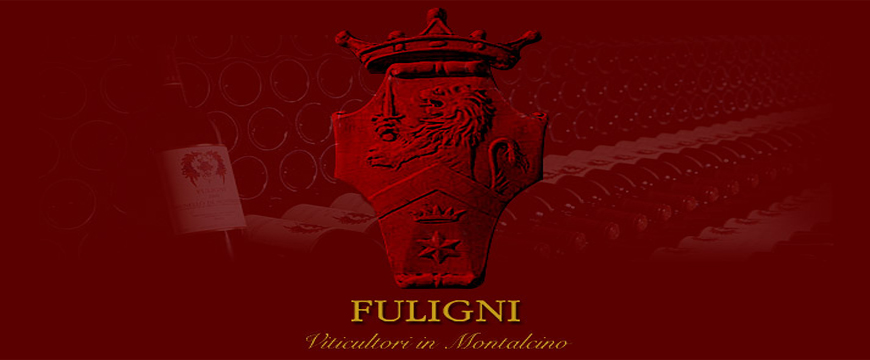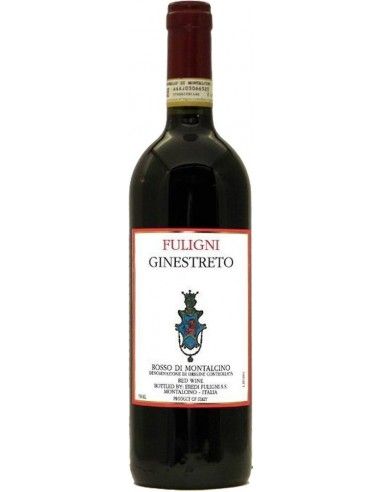-
All Products
TypeWineriesItalyRest of the WorldGreat Wines
- Barolo and its Crus
- Bolgheri
- Bordeaux and the French Bordelais
- Brunello di Montalcino iconic
- Chianti ancient tradition
- Supertuscan the Italian Bordeaux blend
- Syrah Millenary Tradition
- Great International Red Wines
- Great International White Wines
- Amarone in all its elegance
- Pinot Noir from the World
- Timorasso a jewel to discover
-
PROMOTIONS
Promotions
-
Red Wines
ITALY Top Selection Red WinesWORLD Top Selection Red Wines
-
White Wines
ITALY Top Selection White WinesWORLD Top Selection White Wines
-
Rosé Wines
ITALY Top Selection Rosè Wines
-
Sparkling
ChampagneItalian Sparkling WinesEnglish Sparkling Wines
-
Special Wines
Flavoured WinesWines in Amphora
-
Wines to Discover
Rares & AwardedBrands & MakersOrganic & Heroic
-
Spirits
Whiskey
- Wine Makers
- .
Rosso di Montalcino 'Ginestreto' by Fuligni is a fine wine with characteristics similar to those of the most famous Brunello. Matured for 6 months in French oak tonneaux, where it acquires a strong fruity taste, elegant but at the same time ready, snappy and fully enjoyable. A wine certainly of body and particularly versatile for the food pairings.
- Product Category
- Red Wine
- Denomination
- Rosso di Montalcino DOC
- Grape variety / Raw material
- sangiovese
- Vintage or Cuvée
- 2018
- Format
- 750 ml.
- Nation
- Italy
- Region
- IT - Tuscany
- Alcohol Content
- 14% vol.
- Operating Temperature
- 16° – 18° C.
- Recommended Glass
- Wide goblet with a long stem
- Gastronomic Pairings
- Earth Primaries, Roasted Beef, Stewed Meat, Mixed cold cuts, Red Meats
- Allergens
- Contains sulfites (sulfites refer to sulfur dioxide that is added to wine to preserve it, thanks to its disinfectant, antioxidant, and stabilizing action)
Fuligni

In the enchanting Tuscan landscape, among the velvety hills and the vineyards that dance in the sun, the Fuligni winery stands as a beacon of tradition and winemaking mastery. Located in the heart of Montalcino, this small estate is a rare jewel, dedicated to the production of wines that best express the essence of Brunello di Montalcino DOCG. Fuligni intertwines its history with that of the territory, respecting ancient traditions and dedicating itself to the cultivation of a single grape variety: the noble Sangiovese.
Fuligni's production philosophy is a tribute to the classic elegance of Brunello, with obsessive attention to every detail, from the vineyard to the bottle. Here, time passes slowly, allowing the wines to develop the finesse and longevity that make them so appreciated. Each harvest is a unique chapter, written with care and dedication, and translates into wines that tell the story of their territory with authenticity and grace.
Among the winery's top labels, Brunello Riserva is undoubtedly a precious pearl. This wine, the result of a careful selection of the best bunches, enchants with its perfect balance and its complex and persistent aromas. It is an invitation to discover the true soul of Brunello, capable of evolving and surprising over the years, giving unique emotions with every sip.
Explore the Fuligni wine collection on Vino45: a sensory journey through the Tuscan hills, where tradition and passion meet to give life to wine masterpieces of rare beauty.
Address:
Via S.Saloni, 33 53024 Montalcino (SI), Italy
Colore: rubino di bella trasparenza.
Bouquet: aromi fruttati molto puliti, piccoli frutti rossi freschi, sentori di pot: pourri e note speziate.
Gusto: la morbidezza è ben bilanciata dalla integra freschezza, lungo e fruttato finale.

There are no reviews
Reviews

THE WINE
Rosso di Montalcino 'Ginestreto' by Fuligni is a fine wine with characteristics similar to those of the most famous Brunello. Matured for 6 months in French oak tonneaux, where it acquires a strong fruity taste, elegant but at the same time ready, snappy and fully enjoyable. A wine certainly of body and particularly versatile for the food pairings.
THE COMPANY
The Fuligni Estate spreads over approximately one hundred fully-cultivated hectares of land in an almost continual strip on the eastern side of Montalcino where, historically, the most authentic production of Brunello emerged. The vines, which extend over ten hectares, are primarily located at Cottimelli at altitudes varying from 380 to 450 meters above sea level. Here, the land, which predominantly faces east, belongs entirely to the Santa Fiora (marl) geological formation of Eocene origin and is made up of a prevalently rocky terrain.
THE HISTORY
The Fuligni Viscounts, a long-standing Venetian family, moved to England in the 14th century at the head of a troop of mercenaries at the service of Edward III. With the succession of the Absburg- Lorraine to the Grand Duchy, Luigi Fuligni was transferred to Tuscany as general of the new sovereignty and, around 1770, received an extensive concession of land in the Maremma from the Grand Duke, Pietro Leopoldo. Fuligni’s task was to see to the reclamation of the land as was the wish of the enlightened monarch. Giovanni Maria Fuligni settled in Montalcino at the beginning of 1900 and started to produce wine just as his family had previously done predominantly in the area around Scansano in the Maremma. The Fuligni Estate in Montalcino, directed by Maria Flora Fuligni consists of approximately 100 hectares of land at varying exposures to the sun. The vines, which extend over about ten hectares, are situated on the eastern part of the hill, a traditional area for Brunello. The cellars are located at Cottimelli (about three kilometers from Montalcino in the direction of Siena) in an original 18th century residence once the home of Medicean Grand Dukes. Wine tastings are also held on the premises in recently restored rooms which used to accommodate a small monastery of monks in the 16th century.
THE VINEYARDS
The vines, which extend over ten hectares, are primarily located at Cottimelli at altitudes varying from 380 to 450 meters above sea level. Here, the land, which predominantly faces east, belongs entirely to the Santa Fiora (marl) geological formation of Eocene origin and is made up of a prevalently rocky terrain. New vines have been planted facing southeast on land which is a mix of “tufo” and clay. The average age of the vines is about twelve years while some others date back over thirty years preserving the old Sangiovese clones of the estate with a lesser density per hectare. The cultivation system is the classic two-strand trellis with a limited load of buds per plant and with a density which varies from 3.333 to 5.000 main stems per hectare. A thorough pruning is done which involves the important process of thinning out the grapes to ensure a yield per hectare ranging, on average, from 50 to 55 hundred kilos of grapes. The harvest is done manually and includes the personal participation of the owners with frequently repeated walks between the rows of vines to guarantee a rigorous selection of grapes. The various Fuligni vineyards, S. Giovanni, Il Piano, Ginestreto and La Bandita are harvested separately according to their type of land and exposure, and are subsequently brought together keeping in mind the type of wine they are destined to become (Brunello, Brunello Reserve, Rosso DOC).









